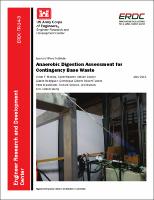Please use this identifier to cite or link to this item:
https://hdl.handle.net/11681/8489Full metadata record
| DC Field | Value | Language |
|---|---|---|
| dc.contributor | Leonard Wood Institute | - |
| dc.contributor | Missouri University of Science and Technology. Department of Civil, Architectural and Environmental Engineering | - |
| dc.contributor | Construction Engineering Research Laboratory (U.S.) | - |
| dc.contributor.author | Medina, Victor F. | - |
| dc.contributor.author | Waisner, Scott A. | - |
| dc.contributor.author | Cosper, Stephen D. | - |
| dc.contributor.author | Rodriguez, Giselle | - |
| dc.contributor.author | Gilbert, Dominique S. | - |
| dc.contributor.author | Tucker, Robert G. | - |
| dc.contributor.author | MacAllister, Irene E. | - |
| dc.contributor.author | Scholze, R. J. (Richard J.) | - |
| dc.contributor.author | Burken, Joel G. (Joel Gerard) | - |
| dc.contributor.author | Wang, Jianwin | - |
| dc.date.accessioned | 2016-06-20T13:27:14Z | - |
| dc.date.available | 2016-06-20T13:27:14Z | - |
| dc.date.issued | 2014-05 | - |
| dc.identifier.uri | http://hdl.handle.net/11681/8489 | - |
| dc.description | Technical Report | - |
| dc.description | Abstract: A study was conducted to evaluate anaerobic digestion as a means of treating organic waste from contingency bases (CBs) and generating energy from the process through biogas. The project focused on laboratory studies to evaluate the treatment of applicable wastes and determine gas production. The study found that food waste is very effectively treated, and generates relatively large gas volumes. Methane concentrations in the gas range from 60 to 70%. Studies with latrine wastes also had high gas production, and inhibition by toilet chemicals was minimal. A pilot study was conducted at the Contingency Base Integration and Technology Evaluation Center (CBITEC) at Ft. Leonard Wood. Calculations suggest that the generated gas could offset energy use by 15 to 30%, depending on the size of the CB, and fuel cost savings (fully burdened and incorporating estimates for force protection) were estimated to be as high as $500,000 per month. Some issues were identified regarding reaction instabilities that could cause the reactors to fail. Some solutions were suggested to address these issues; one in particular uses a mix of wastes, along with food, and this mixture should improve stability and increase the utility of the process. | - |
| dc.publisher | Environmental Laboratory (U.S.) | - |
| dc.publisher | Engineer Research and Development Center (U.S.) | - |
| dc.relation | http://acwc.sdp.sirsi.net/client/en_US/search/asset/1034690 | - |
| dc.relation.ispartofseries | ERDC TR ; 14-3. | - |
| dc.rights | Approved for public release; distribution is unlimited. | - |
| dc.source | This Digital Resource was created in Microsoft Word and Adobe Acrobat | - |
| dc.subject | Anaerobic digestion | - |
| dc.subject | CBs | - |
| dc.subject | Contingency bases | - |
| dc.subject | Biogas | - |
| dc.subject | Energy generation | - |
| dc.subject | Organic waste | - |
| dc.subject | CBITEC | - |
| dc.subject | Contingency Base Integration and Technology Evaluation Center | - |
| dc.subject | Leonard Wood Institute | - |
| dc.title | Anaerobic digestion assessment for contingency base waste | - |
| dc.type | Report | en_US |
| Appears in Collections: | Technical Report | |
Files in This Item:
| File | Description | Size | Format | |
|---|---|---|---|---|
| ERDC-TR-14-3.pdf | 4.43 MB | Adobe PDF |  View/Open |